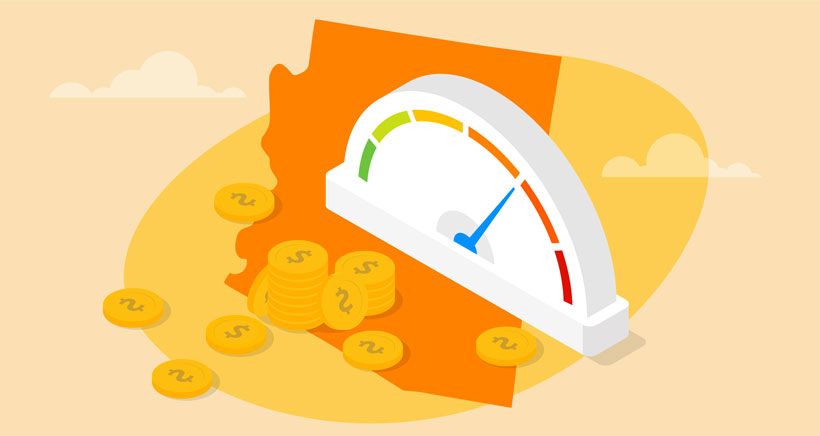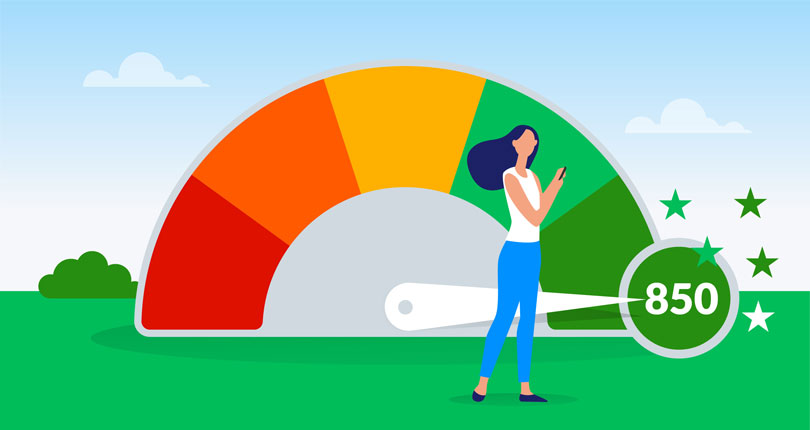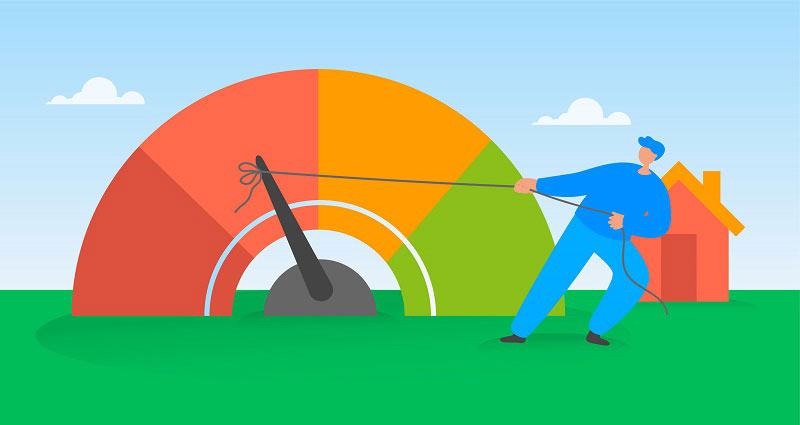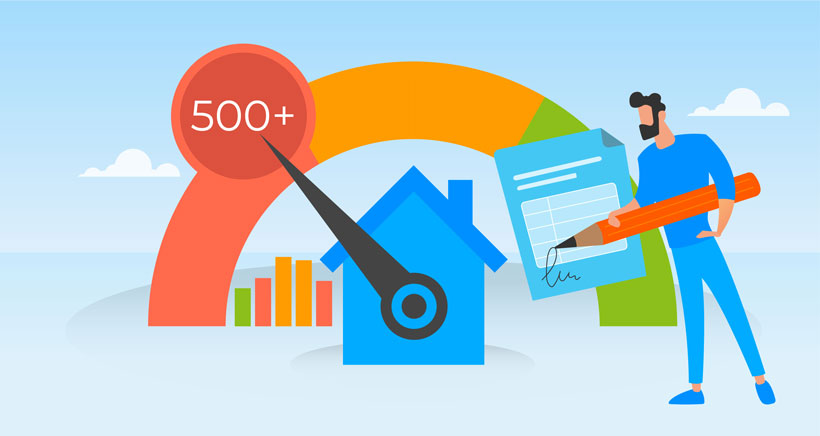
The average VantageScore in Arizona is 684. The average household debt is $54,290.
The last of the contiguous 48 states to be admitted to the union, Arizona grew as the result of western expansion. Its economy began back in the mid-1800s with the "five C's": copper, cotton, cattle, citrus, and the climate that made settling the state very attractive for people escaping the harsh winters of the East. Since then, the state has grown to be a major hub of the Sun Belt.
Arizonans’ relationship with debt is a complicated one. The statistics are full of fluctuations, and the state’s issues with debt are as diverse as its population. Let’s take a look at Arizona’s relationship with credit and debt.
Key Statistics
- The average VantageScore in Arizona is 684. The national average is 690.
- The average mortgage balance in Arizona is $210,872. The average mortgage balance nationwide is $208,185. [16] Mortgage Debt Sees Record Growth Despite Pandemic https://www.experian.com/blogs/ask-experian/how-much-americans-owe-on-their-mortgages-in-every-state/
- The cost of owning and maintaining a vehicle in Arizona is $2,748. The national average is $2,671. [17] The Annual Cost of Car Ownership in Every State https://moneywise.com/a/annual-cost-of-car-ownership-in-every-state
- Arizonans owe an average of $9,410 more than they make. The per capita income in Arizona is $43,650. The per capita debt balance is $53,060.
- From 2019 to 2020, Arizona had a significant 9-point increase in average credit score from 675 to 684, the second highest jump in the country within that time period.
- Arizona ranks sixth in the states that have taken advantage of cash-out refinancing of their mortgages.
Arizona’s Average VantageScore Over Time
| Year | Average VantageScore - AZ |
|---|---|
| 2015 | 662 |
| 2016 | 718 |
| 2017 | 669 |
| 2018 | 673 |
| 2019 | 675 |
| 2020 | 684 |
The trend of Arizona’s VantageScore over time has somewhat tracked the national average with a difference between the two of no more than 10 points. Arizona has remained in the “Good” range between 670 and 739, with the exception of 2015 and 2017 when it dipped to 662 and 669, respectively.
Interestingly, Arizona’s VantageScore spiked to 718 in 2016. It’s hard to pinpoint a single reason for this spike. Rather, several factors converged in 2016 and certainly could have contributed to this spike. In 2016, Arizona’s GDP outpaced projections. Additionally, the Phoenix, Mesa, and Scottsdale areas began to lure tech jobs away from Silicon Valley, and the state boasted the second fastest job growth rate in the country. [1] A positive outlook: Arizona’s economy is strong and rising! https://phoenixchamber.com/2016/10/13/arizonas-economy-is-strong-and-rising/

How to Build Credit When You Have None
Building credit from scratch can be a lot easier when you understand where to start and which mistakes to avoid.
Download our guideHow Credit Scores in Arizona Compare to Other States
| Year | Average VantageScore - AZ | Average VantageScore - US |
|---|---|---|
| 2015 | 662 | 672 |
| 2016 | 718 | 726 |
| 2017 | 669 | 678 |
| 2018 | 673 | 682 |
| 2019 | 675 | 684 |
| 2020 | 684 | 690 |
From 2019 to 2020, Arizona experienced a significant 9-point increase in average credit score from 675 to 684, the second highest jump in that time period. Only West Virginia had the same 9-point jump. Connecticut is the only state that had a higher jump (10 points) in the same time period.
Arizona is tied with Alaska with a score of 684. Indiana (682) and Florida (680) are right behind Arizona, while Missouri (685), Ohio (687), Delaware (687), and Maryland (688) are just a few points above.
Debt in Arizona
| Year | Average Household Debt - AZ | Average Household Debt - US |
|---|---|---|
| 2003 | 37,720 | 33,430 |
| 2004 | 41,950 | 37,290 |
| 2005 | 46,190 | 40,650 |
| 2006 | 55,550 | 45,410 |
| 2007 | 63,750 | 50,170 |
| 2008 | 65,870 | 52,010 |
| 2009 | 60,200 | 49,820 |
| 2010 | 54,320 | 47,410 |
| 2011 | 52,210 | 47,790 |
| 2012 | 48,890 | 47,020 |
| 2013 | 46,950 | 45,310 |
| 2014 | 47,230 | 45,710 |
| 2015 | 47,630 | 46,000 |
| 2016 | 48,590 | 46,950 |
| 2017 | 51,300 | 48,800 |
| 2018 | 53,060 | 50,090 |
| 2019 | 54,290 | 51,580 |
One thing is clear about the statistics for Arizonans’ household debt: The Great Recession hit the state hard. The widest gap between Arizona’s household debt and the national average occurs during the financial crisis that began in 2008. The gap narrows as the state emerges from the recession and returns to its trend of being just above the national average.
According to a 2019 study by the Motley Fool, Arizona ranked fourth among the top 15 states whose residents owe more than they make. Hawaii holds first place, with an $18,025 dollar difference between the per capita debt balance of its residents ($53,060) and their per capita income ($43,650). Arizona’s difference is $9,410. [3] Americans in These 15 States Owe More Money Than They Earn Annually https://www.fool.com/the-ascent/research/americans-these-15-states-owe-more-money-they-earn-annually/
Mortgage Debt
| Year | Average Mortgage Debt - AZ | Average Mortgage Debt - US |
|---|---|---|
| 2003 | 27,360 | 23,740 |
| 2004 | 30,180 | 26,590 |
| 2005 | 33,770 | 29,230 |
| 2006 | 42,080 | 33,400 |
| 2007 | 48,930 | 37,250 |
| 2008 | 50,220 | 38,490 |
| 2009 | 45,540 | 36,810 |
| 2010 | 40,860 | 35,010 |
| 2011 | 38,000 | 34,200 |
| 2012 | 34,800 | 33,230 |
| 2013 | 33,150 | 31,630 |
| 2014 | 33,070 | 31,520 |
| 2015 | 33,000 | 31,330 |
| 2016 | 33,370 | 31,590 |
| 2017 | 35,680 | 32,940 |
| 2018 | 36,690 | 33,680 |
| 2019 | 37,620 | 34,790 |
Mortgage debt in Arizona mirrors the trend shown in household debt, which makes sense as the cost of a house often makes up a large percentage of a household’s overall debt. Recently, however, mortgage debt appears to be once more widening the gap between Arizona homeowners and the rest of the country. Arizonans who own their homes saw their average mortgage debt climb 1.4% from 2018 to 2019. [2] Arizonans owe more money than they earn, report says https://www.bizjournals.com/phoenix/news/2019/07/29/arizonans-owe-more-money-than-they-earn-report.html
Arizona was hit hard during the recession of 2008. In Phoenix, homes lost more than 56 percent of their value. [4] 10 Years After Housing Crisis: A Realtor, A Renter, Starting Over, Staying Put https://www.npr.org/2018/04/28/603678259/10-years-after-housing-crisis-a-realtor-a-renter-starting-over-staying-put Interestingly enough, Arizona has rebounded from a debilitating financial crisis and is heading toward an affordable housing crisis. The slowly-widening gap between Arizona’s mortgage debt and the national average can be explained by post-recession wages decreasing, while housing costs are rising. [5] (Un)Affordable: How Did Arizona End Up With A Housing Crisis? https://kjzz.org/content/1118776/unaffordable-how-did-arizona-end-housing-crisis Housing costs in Arizona are on average 7.8 percent higher than the national average. [6] Cost of living in Arizona https://www.bestplaces.net/cost_of_living/state/arizona The median home price in Arizona is $249,300, while the median home price nationally is $231,200.
Another disturbing recent trend is the increase in cash-out refinancing. Arizona currently ranks sixth in the nation in recent refinancing, while 60 percent of recent refinancing is cash-out nationally. [15] Places Taking on the Most Mortgage Debt in America https://www.refiguide.org/which-places-in-america-are-taking-the-most-mortgage-debt/ This type of refinancing is problematic, compared to the act of simply rolling over a mortgage to reduce your payment thanks to a lower interest rate. Cash-out means you're taking the equity in your home in cash, which can help with short-term needs but often leads to refinancing a larger amount with a larger monthly payment. When this occurs just before a recession, like the one we’re in now, it can lead to being underwater on your mortgage. The last time the country saw a surge in cash-out refinancing was the Great Recession of 2008.
Credit Card Debt
| Year | Average Credit Card Debt - AZ | Average Credit Card Debt - US |
|---|---|---|
| 2003 | 3,110 | 2,960 |
| 2004 | 3,170 | 3,040 |
| 2005 | 2,970 | 3,060 |
| 2006 | 3,100 | 3,170 |
| 2007 | 3,590 | 3,490 |
| 2008 | 3,990 | 3,670 |
| 2009 | 3,740 | 3,370 |
| 2010 | 3,270 | 3,050 |
| 2011 | 3,060 | 2,950 |
| 2012 | 2,930 | 2,850 |
| 2013 | 2,740 | 2,710 |
| 2014 | 2,740 | 2,730 |
| 2015 | 2,810 | 2,800 |
| 2016 | 2,930 | 2,930 |
| 2017 | 3,140 | 3,100 |
| 2018 | 3,310 | 3,220 |
| 2019 | 3,460 | 3,390 |
The level of credit card debt in Arizona has fluctuated significantly. Coming out of a steep spike during the Great Recession, the level of credit card debt settled back below pre-recession levels by 2013, but then started rising again and continues to rise.
A 2019 study rated Phoenix one of the least sustainable cities with regards to its credit card debt. The study determined it would take almost 4.5 years and cost over $1,000 for an Arizonan to pay off the median credit card debt amount of $2,633. [7] Phoenix Among Cities With Least-Sustainable Credit Card Debt https://patch.com/arizona/phoenix/phoenix-among-cities-least-sustainable-credit-card-debt By comparison, Cupertino, California—the top-ranked city—could pay off roughly the same amount of debt in just over a year.
By contrast, the city of Tempe, Arizona ranked first in the state and 14th nationally for paying down credit card debt. Tempe households reduced their credit card debt by by an average of $2,347 from 2017 to 2018. [8] Consumers in what Phoenix-area cities have highest credit-card debt? And see who's paying it down https://www.azcentral.com/story/news/local/tempe/2019/03/24/tempe-residents-successfully-eliminate-significant-amount-debt/3144582002/
Auto Loan Debt
| Year | Average Auto Loan Debt - AZ | Average Auto Loan Debt - US |
|---|---|---|
| 2003 | 3,420 | 2,960 |
| 2004 | 3,800 | 3,040 |
| 2005 | 4,030 | 3,240 |
| 2006 | 4,220 | 3,360 |
| 2007 | 4,350 | 3,360 |
| 2008 | 4,190 | 3,310 |
| 2009 | 3,610 | 3,030 |
| 2010 | 3,290 | 2,950 |
| 2011 | 3,330 | 3,050 |
| 2012 | 3,540 | 3,270 |
| 2013 | 3,710 | 3,420 |
| 2014 | 4,050 | 3,720 |
| 2015 | 4,480 | 4,070 |
| 2016 | 4,750 | 4,340 |
| 2017 | 4,890 | 4,520 |
| 2018 | 5,200 | 4,700 |
| 2019 | 5,350 | 4,850 |
For an expansive state whose public transit options do not extend much beyond the bus and a regional rail system connecting Mesa and Tempe, cars are vitally important. The iconic Route 66 passes through both Flagstaff and Kingman. Unfortunately for Arizonans, the average cost of owning and maintaining a vehicle is seven percent higher for Arizona than it is for the rest of the country. [7] Phoenix Among Cities With Least-Sustainable Credit Card Debt https://patch.com/arizona/phoenix/phoenix-among-cities-least-sustainable-credit-card-debt In a state full of fluctuations, auto loan debt is one area where Arizona consistently ranks above the national average.
Arizona ranks 11th among the states with the most auto loan debt from 2018 to 2019 with a one percent year-over-year increase. [9] Top 10 States With the Highest Average Auto Loan Debt https://www.experian.com/blogs/ask-experian/research/states-with-the-highest-average-auto-loan-debt/ Arizona also has a 4.57 percent delinquency rate for auto loans 90 days or more past due. [10] The 20 states with the most auto loan debt https://azdailysun.com/lifestyles/autos/the-20-states-with-the-most-auto-loan-debt/collection_e9968ebe-731f-573b-93f2-9ce02fb938df.html#10
The Arizona Attorney General gave the state’s consumers some good news in March 2020 when he announced new protections that limited repossessions in response to the COVID-19 pandemic. [11] Major Consumer Protections Announced in Response to COVID-19 https://library.nclc.org/major-consumer-protections-announced-response-covid-19 These restrictions will likely help keep that gap between Arizona’s auto debt and the national average from widening.
Student Loan Debt
| Year | Average Student Loan Debt - AZ | Average Student Loan Debt - US |
|---|---|---|
| 2003 | 1,080 | 1,060 |
| 2004 | 1,520 | 1,440 |
| 2005 | 1,670 | 1,610 |
| 2006 | 1,930 | 1,970 |
| 2007 | 2,170 | 2,250 |
| 2008 | 2,500 | 2,670 |
| 2009 | 2,890 | 3,010 |
| 2010 | 3,220 | 3,370 |
| 2011 | 3,420 | 3,620 |
| 2012 | 3,890 | 4,000 |
| 2013 | 4,030 | 4,250 |
| 2014 | 4,310 | 4,490 |
| 2015 | 4,470 | 4,660 |
| 2016 | 4,690 | 4,920 |
| 2017 | 4,890 | 5,130 |
| 2018 | 5,170 | 5,390 |
| 2019 | 5,260 | 5,510 |
Like many other states, Arizona’s student loan debt trend tracks the national average. While Arizona is slightly below the national average, the upward trajectory over time continues and the debt burden of Arizona’s college students rises with it. Arizona students owe an average of $34,712 in student debt. [12] Arizona Student Loans: Debt Stats, Repayment Programs and Refinancing Loans https://studentloanhero.com/featured/arizona-student-loans-refinance/ In a state where the median individual income is around $30,000 [13] Data Commons Place Explorer - Arizona https://datacommons.org/place/geoId/04?topic=Economics#Median%20individual%20income, that’s a problem. One of the factors contributing to this is a small number of public universities in the state. Arizona has a grand total of three: Arizona State, Northern Arizona University, and the University of Arizona. Compare this to a state like Pennsylvania with 58 public university options and you can see how competitive access to lower cost higher education options can get.
Another factor contributing to Arizona’s student debt problem is a paucity of grant options offering too little money to make a difference. Arizona has AZLEAP (the Arizona Leveraging Educational Assistance Partnership) which can offer up to $2,500 per academic year to students who demonstrate financial need. [12] Arizona Student Loans: Debt Stats, Repayment Programs and Refinancing Loans https://studentloanhero.com/featured/arizona-student-loans-refinance/ While this is better than nothing, it’s still a drop in the bucket compared to the total cost of college for a year. Students who do not qualify for this grant are left with either private or state loans to fill in the gap.
An unfortunate consequence of students shouldering this much debt is a high level of default rates on student loans. In 2016, when Arizona’s level of student debt was slightly below the national average, its default rate had inched one percent above the national average (10.8 percent) to 11.45 percent. [14] Arizona Student Loan Default Rates Above National Average https://kjzz.org/content/1288691/arizona-student-loan-default-rates-above-national-average
Sources
- [1] A positive outlook: Arizona’s economy is strong and rising! https://phoenixchamber.com/2016/10/13/arizonas-economy-is-strong-and-rising/
- [2] Arizonans owe more money than they earn, report says https://www.bizjournals.com/phoenix/news/2019/07/29/arizonans-owe-more-money-than-they-earn-report.html
- [3] Americans in These 15 States Owe More Money Than They Earn Annually https://www.fool.com/the-ascent/research/americans-these-15-states-owe-more-money-they-earn-annually/
- [4] 10 Years After Housing Crisis: A Realtor, A Renter, Starting Over, Staying Put https://www.npr.org/2018/04/28/603678259/10-years-after-housing-crisis-a-realtor-a-renter-starting-over-staying-put
- [5] (Un)Affordable: How Did Arizona End Up With A Housing Crisis? https://kjzz.org/content/1118776/unaffordable-how-did-arizona-end-housing-crisis
- [6] Cost of living in Arizona https://www.bestplaces.net/cost_of_living/state/arizona
- [7] Phoenix Among Cities With Least-Sustainable Credit Card Debt https://patch.com/arizona/phoenix/phoenix-among-cities-least-sustainable-credit-card-debt
- [8] Consumers in what Phoenix-area cities have highest credit-card debt? And see who's paying it down https://www.azcentral.com/story/news/local/tempe/2019/03/24/tempe-residents-successfully-eliminate-significant-amount-debt/3144582002/
- [9] Top 10 States With the Highest Average Auto Loan Debt https://www.experian.com/blogs/ask-experian/research/states-with-the-highest-average-auto-loan-debt/
- [10] The 20 states with the most auto loan debt https://azdailysun.com/lifestyles/autos/the-20-states-with-the-most-auto-loan-debt/collection_e9968ebe-731f-573b-93f2-9ce02fb938df.html#10
- [11] Major Consumer Protections Announced in Response to COVID-19 https://library.nclc.org/major-consumer-protections-announced-response-covid-19
- [12] Arizona Student Loans: Debt Stats, Repayment Programs and Refinancing Loans https://studentloanhero.com/featured/arizona-student-loans-refinance/
- [13] Data Commons Place Explorer - Arizona https://datacommons.org/place/geoId/04?topic=Economics#Median%20individual%20income
- [14] Arizona Student Loan Default Rates Above National Average https://kjzz.org/content/1288691/arizona-student-loan-default-rates-above-national-average
- [15] Places Taking on the Most Mortgage Debt in America https://www.refiguide.org/which-places-in-america-are-taking-the-most-mortgage-debt/
- [16] Mortgage Debt Sees Record Growth Despite Pandemic https://www.experian.com/blogs/ask-experian/how-much-americans-owe-on-their-mortgages-in-every-state/
- [17] The Annual Cost of Car Ownership in Every State https://moneywise.com/a/annual-cost-of-car-ownership-in-every-state






